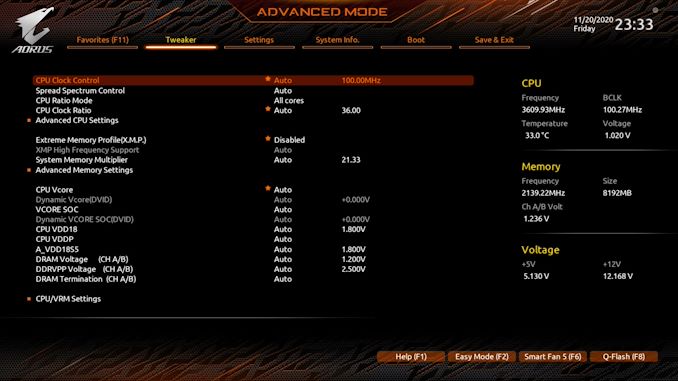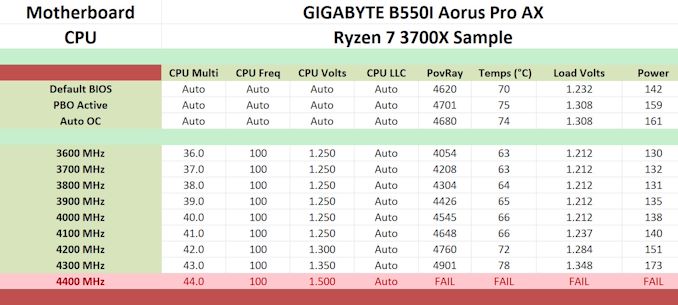The GIGABYTE B550I Aorus Pro AX Motherboard Review: All The Small Things
by Gavin Bonshor on December 7, 2020 10:00 AM ESTOverclocking Ryzen 3000
Experience with the GIGABYTE B550I Aorus Pro AX
When it comes to overclocking AMD's Ryzen 3000, pushing them to even modest all-core frequencies can mean they run very hot. Even with the most recent Zen 3 based Ryzen 5000 processors, Robert Hallock, who is AMD's Director of Technical Marketing, stated in response to a Redditor that they (Ryzen 5000) could quickly hit up to 95 degrees Celsius under full-load. According to Robert Hallock, this is a part of the design and should allow the Ryzen 5000 series chips to boost longer due to the higher temperature threshold, thus giving better performance all across the board. It is recommended that users looking to overclock Ryzen 3000, or even contemplate using the Ryzen 5000 series, do invest in adequate CPU cooling with premium AIO closed-loop coolers looking like the most strong candidates outside of the expensive custom liquid solutions on the market.
Focusing on our experience with the GIGABYTE B550I Aorus Pro AX, the firmware itself is user friendly and responsive as far as a BIOS goes. All of the relevant overclocking settings can be found within the Tweaker section, with options to overclock the CPU, iGPU, and memory all found here. Users can use the CPU ratio mode to make adjustments to the core clock speed, while fine tweaking can be done via the base clock under the CPU Clock Control option. For voltages, the CPU VCore is the most prominent option for pushing more juice to the CPU, while options to change the level of Load-Line Calibration of the 8-phase power delivery can be found under the CPU/VRM settings.
Memory overclocking can be done multiple ways, with X.M.P 2.0 profiles available by enabling the profile on compatible memory for ease of use. Other options for tuning the memory manually with the System Memory multiplier, altering the DRAM voltage, and a section dedicated to tweaking the memory timings. As we've previously noted in previous AM4 reviews, AMD recommends a maximum FCLK (Infinity Fabric Clock) to within 2:1 of the memory frequency, with the sweet spot sitting at DDR4-3600 with an FCLK of 1800 MHz.
Overclocking Methodology
Our standard overclocking methodology is as follows. We select the automatic overclock options and test for stability with POV-Ray and OCCT to simulate high-end workloads. These stability tests aim to catch any immediate causes for memory or CPU errors.
For manual overclocks, based on the information gathered from the previous testing, start off at a nominal voltage and CPU multiplier, and the multiplier is increased until the stability tests are failed. The CPU voltage is increased gradually until the stability tests are passed. The process is repeated until the motherboard reduces the multiplier automatically (due to safety protocol) or the CPU temperature reaches a stupidly high level (105ºC+). Our testbed is not in a case, which should push overclocks higher with fresher (cooler) air.
We overclock with the Ryzen 7 3700X for consistency with our previous overclocking tests.
Overclocking Results
Equipped with a solid 8-phase power delivery, the mini-ITX GIGABYTE performs pretty competitively in our overclocking tests. Not only is the B550I Aorus Pro AX more than capable of pushing a Ryzen 3000 beyond its limits comfortably, but it behaves very well in regards to VDroop in our manual testing. Our AM4 testing with the Ryzen 7 3700X stretches starts from 3.6 GHz and goes as far as we can in the headroom. Although our Ryzen 7 3700X, unfortunately, cannot do 4.4 GHz fully stable, 4.3 GHz is still a good overclock all-cores.
Our POV-Ray benchmark performance increased as we tested each frequency from 3.6 GHz to 4.3 GHz, with solid levels of VDroop control when comparing load CPU VCore to the values set within the BIOS. Naturally, as we increased the frequency, we saw higher temperatures a full load, but not as much when we upped the CPU VCore from 1.25 V to 1.30 and beyond. Power also crept up as we increased the frequency and CPU VCore, which is expected as more juice means more power from the wall.












76 Comments
View All Comments
mopelo - Monday, December 14, 2020 - link
I get paid more than 120 to 130 per hour for working online. I heard about this job 3 months ago and after joining this i have earned easily 15000$ from this without having online working skills. This is what I do.....___https://bit.ly/37iSHNXRonzino - Sunday, January 24, 2021 - link
This mobo is more than wonderful just because it offer two pcie slots,simply buying an adaptor from m2 to pcie16x(4x electrical), you can use the back m2 slot as an addition slot. It is exactly what I was looking for... Mini itx with 2 pcie slots.worldnewsnow - Friday, March 12, 2021 - link
https://nativenewspost.com/https://nativenewspost.com/best-deals/
https://nativenewspost.com/news/entertainment/
https://nativenewspost.com/news/business/
Samuel Vimes - Saturday, March 13, 2021 - link
In mini-ITX format, the MPG B550I GAMING EDGE WIFI is IMHO the better choice because of its M.2 active cooling (when we know PCIe Gen4 SSD tend to heat-throttle). It's PWM regulated so its temp-speed curve can be adjusted (or switched off) so it's all bonus, and in a cramp mini-ITX build (not a test bench), the active Gen4 cooling will make a difference.Flying Aardvark - Wednesday, April 14, 2021 - link
Samuel Vimes that is a valid point. That said, I always prefer fanless boards. It's not really "help" to add a fan.. you can add any (industry standard) fan you'd like to anything. No reason for vendors to help us with that, which is often a difficult to source and replace proprietary fan. At minimum they need to advertise they're using a standard 40mm fan so you can drop in a Noctua or whatever you like instead. I use an Asus X470-i but my favorite board on the market today is this Gigabyte B550i. Both of the Asus 500 series boards have fans on them, but they're used on the VRM directly not the M.2 so it's even worse than what MSI did.robertwesle - Monday, November 1, 2021 - link
Netflix's services are occasionally of excellent quality, users may have issues when using them. To fix any issue that causes Netflix not to work, users can try the solutions given in this post.......https://ondersteuning322650909.wordpress.com/2021/...